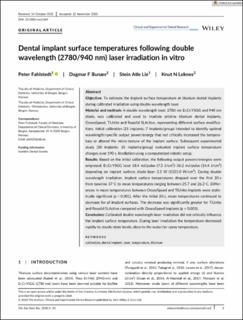| dc.contributor.author | Fahlstedt, Peter | |
| dc.contributor.author | Bunæs, Dagmar | |
| dc.contributor.author | Lie, Stein Atle | |
| dc.contributor.author | Leknes, Knut N. | |
| dc.date.accessioned | 2021-07-05T12:12:59Z | |
| dc.date.available | 2021-07-05T12:12:59Z | |
| dc.date.created | 2021-01-17T22:13:38Z | |
| dc.date.issued | 2020 | |
| dc.identifier.issn | 2057-4347 | |
| dc.identifier.uri | https://hdl.handle.net/11250/2763415 | |
| dc.description.abstract | Objective: To estimate the implant surface temperature at titanium dental implants during calibrated irradiation using double wavelength laser.
Material and methods: A double wavelength laser, 2780 nm Er,Cr:YSGG and 940 nm diode, was calibrated and used to irradiate pristine titanium dental implants, OsseoSpeed, TiUnite and Roxolid SLActive, representing different surface modifications. Initial calibration (21 implants; 7 implants/group) intended to identify optimal wavelength/specific output power/energy that not critically increased the temperature or altered the micro-texture of the implant surface. Subsequent experimental study (30 implants; 10 implants/group) evaluated implant surface temperature changes over 190 s. Irradiation using a computerized robotic setup.
Results: Based on the initial calibration, the following output powers/energies were employed: Er,Cr:YSGG laser 18.4 mJ/pulse (7.3 J/cm2)–36.2 mJ/pulse (14.4 J/cm2) depending on implant surface; diode laser 3.3 W (1321.0 W/cm2). During double wavelength irradiation, implant surface temperatures dropped over the first 20 s from baseline 37°C to mean temperatures ranging between 25.7 and 26.3°C. Differences in mean temperatures between OsseoSpeed and TiUnite implants were statistically significant (p < 0.001). After the initial 20 s, mean temperatures continued to decrease for all implant surfaces. The decrease was significantly greater for TiUnite and Roxolid SLActive compared with OsseoSpeed implants (p < 0.001).
Conclusion: Calibrated double wavelength laser irradiation did not critically influence the implant surface temperature. During laser irradiation the temperature decreased rapidly to steady-state levels, close to the water/air-spray temperature. | en_US |
| dc.language.iso | eng | en_US |
| dc.publisher | Wiley | en_US |
| dc.rights | Navngivelse 4.0 Internasjonal | * |
| dc.rights.uri | http://creativecommons.org/licenses/by/4.0/deed.no | * |
| dc.title | Dental implant surface temperatures following double wavelength (2780/940 nm) laser irradiation in vitro | en_US |
| dc.type | Journal article | en_US |
| dc.type | Peer reviewed | en_US |
| dc.description.version | publishedVersion | en_US |
| dc.rights.holder | Copyright 2020 the authors | en_US |
| cristin.ispublished | true | |
| cristin.fulltext | original | |
| cristin.qualitycode | 1 | |
| dc.identifier.doi | 10.1002/cre2.369 | |
| dc.identifier.cristin | 1872743 | |
| dc.source.journal | Clinical and Experimental Dental Research | en_US |
| dc.identifier.citation | Clinical and Experimental Dental Research. 2020. | en_US |

